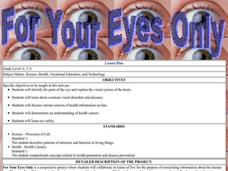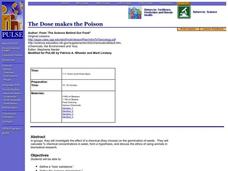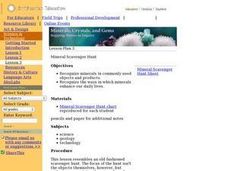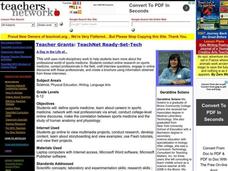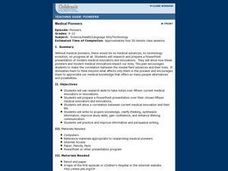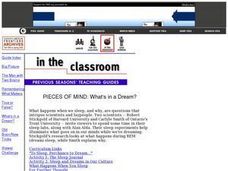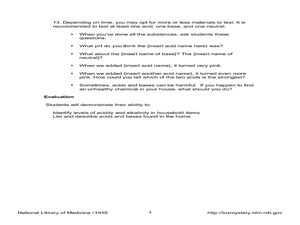Curated OER
For Your Eyes Only
Students complete several activities in a unit related to the eye. In this eye lesson, students work in groups to research information about the human eye and create a multimedia presentation. They research anatomy of the eye, how the...
Curated OER
Designing Babies
Learners analyze current and emerging techniques used to select specific characteristics in offspring. They examine specific case studies and make ethical decisions based upon the Ethical Decision-Making Model.
Curated OER
Mosquito Bytes
Students investigate mosquitoes. In this mosquito bytes lesson, students consider reasons why mosquitoes transfer disease and ways to combat them. Students read an article, discuss, and complete a quiz.
Curated OER
The Dose makes the Poison
Students investigate the effect of a chemical (they choose) on the germination of seeds. They calculate % chemical concentrations in water, form a hypothesis, and discuss the ethics of using animals in biomedical research.
Curated OER
Are We Couch Potatoes or Busy Bees? Data Analysis of Physical Activity in School
Young scholars study practical data analysis within the constraints of the scientific method. For this data lesson students collect and enter data into a computer spreadsheet then create graphs.
Curated OER
SMOKING: A RISK WORTH TAKING OR JUST A DRAG?
High schoolers identify and state a tobacco-related decision problem/issue, viable options regarding the selected problem; research and discuss risks and benefits associated with the decision problem; and state a decision based upon...
Curated OER
Air Pollution: What's the Solution?
For this air pollution worksheet, students watch a video about asthma and indicate the triggers of asthma. They also use a web site to get real time data about the ozone, particle pollution and air quality to answer four...
Curated OER
Mineral Scavenger Hunt
Students complete a scavenger hunt worksheet as they find examples in their classroom, at home, etc., of minerals. Excellent worksheet!
Curated OER
Flambe Elements
Eighth graders discuss atoms and electrons as well as atoic structure. They view atomic structure via the computer. Students watch a demonstration in which the teacher demonstrates glass tubing turning yellow in a Bunsen Burner flame....
Curated OER
A Day in the Life
Students research questions related to sports medicine. They write an essay from the questions and create professional email accounts to email a professional in their field of interest. In addition, they interview their professional and...
Curated OER
Biology: New Trials & Findings
Students use background knowledge to summarize articles about skin cancer research and present them to the class and place their studies along a clinical study timeline. They are introduced to clincal trails and to various aspects of...
Curated OER
What Makes a Home "Energy Efficient"?
Learners research and report the costs and benefits of making their own homes more energy efficient. In this energy conservation lesson, students explore energy efficient technologies and design over several days. They complete a home...
Curated OER
Do Medicines Grow on Trees and Plants?
Students study the importance of preserving rainforest. They investigate the uses of rainforest plants for medicinal uses by participating in rainforest immersion activities.
Curated OER
America's Underwater Treasures Viewing Guide
Young scholars complete a worksheet while watching a video about how humans affect the ocean environment. They discover the need for a practice of balancing fisheries and their fishing practices. They examine how scientists use data to...
Curated OER
Food Pyramid-Planning a Healthy Meal
Students identify the five basic food groups. They use their knowledge of the food pyramid to plan a full meal that incorporates at least one serving of food from each group. Pupils classify their ingredients according to the food groups.
Curated OER
What Is It?
Play the game of Tag and differentiate between plants and animals. Explore the characteristics of plants. Identify the major parts of plants (e.g., seeds, stem, pistil) and describe their basic functions. Compare the requirements of some...
Curated OER
TE Lesson: Out of Breath
Students study the parts of the human respiratory system while examining the gas exchange that takes place in the lungs. They make a model lung. They look at how the respiratory system is affected by spaceflight.
Curated OER
Medical Pioneers
Students use research skills to take notes over fifteen current medical innovators or innovations. They prepare a PowerPoint presentation over their chosen fifteen medical innovators and innovations. Students show a correlation between...
Curated OER
Pieces of Mind: What's In A Dream?
Students explore the five stages of sleep. They view video footage of sleep labs and discuss the findings. Students conduct experiments by keeping a sleep journal to track their sleep and dream activity. They find examples of ways...
Curated OER
Plants and Animals: Partners in Pollination
Students describe the complementary relationships between pollinators and the plants they pollinate, identify adaptations that flowers have developed to "encourage" pollination, and create and draw their own "designer" flowers.
Curated OER
Create a Classroom Exhibit: Rocks and Minerals
Students bring in rocks and minerals from home. They observe them and describe them carefully, completing a worksheet. Finally, a classroom exhibit is created.
Curated OER
Plants and Animals, Partners in Pollination
Students participate in multiple hands-on activities to explore reproduction and pollination. In groups, using a cotton swab and powder, students simulate being pollinators and plants. They name the parts of the flowers and the function...
Curated OER
Rocks and Minerals
Learners bring rocks and minerals from home to investigate in the classroom. In this rocks and minerals lesson plan, students observe all the rocks and minerals brought into the class and answer 7 questions about the features of the...
Curated OER
Acid or Base? Toxie's on the Case
Students recognize the difference between acids and bases. In this ToxMystery lesson, students play a computer game and experiment to find the difference between acids and bases. Students use litmus paper to determine if household...
